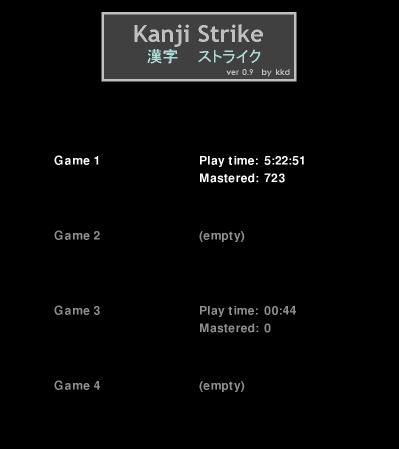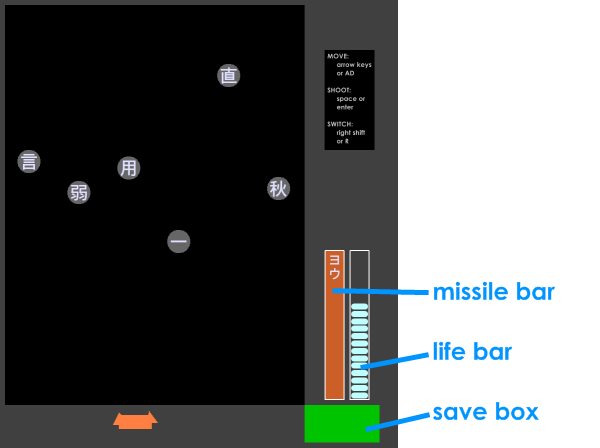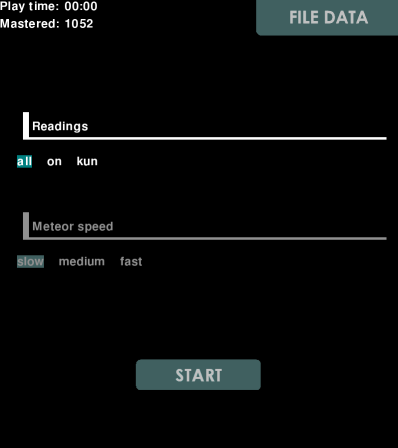- Setup instructions
- The data
- Gameplay
- Controls
- Title screen
- Menu screen
- Data screen
- Game screen
- Acknowledgements
Setup instructions
- Install Python.
- Install Pygame.
- Download the latest Kanji Strike package and unpack it in a convenient folder.
Start the game by running kanji_strike.py from the command line or by clicking on it in a file browser.
Gameplay - Controls
Kanji Strike uses keyboard controls only.
Arrow keys or WASD: navigate menus, move target.
Space or Enter: press button, confirm selection, shoot missile.
Right Shift or 'R': switch missile.
Gameplay - Title Screen
There are four save files. Each file records which kanji-pronunciation pairs a player has mastered.

Gameplay - Menu Screen
The menu screen lets the player alter game settings.
Gameplay - Data Screen
Shows how much the player has mastered, by grade level. Also allows the player to delete the save file currently in use.
Edit save file: The player can mark all the pronunciations in a given grade level mastered or unmastered. Players with advanced knowledge of kanji can use this to skip the first few grades.
Return to title screen: Self-explanatory.
Delete save file: Delete the save file currently loaded. The player is asked to confirm before the delete is carried out.

Gameplay - Game Screen
The player starts with 20 life points. When a meteor reaches the bottom of the screen, it explodes and causes 10 points damage. A life point is gained every time the player shoots down a meteor. Zero life points means game over.
The player shoots down meteors by matching the pronunciation on the missile with the character on the meteor. More than one meteor can be 'correct' at a time.
The player can also get a new missile with a new pronunciation by pressing space. However, this costs two life points.
Every two minutes or so, a green save box appears beneath the life and missile bars. The player can drive into the save box to end the current game and return to the menu screen.

The data
The data is a list of kanji-pronunciation pairs taken from the KANJIDIC dictionary file. For example, the kanji 聞 has 4 pronunciations: ブン, モン, き.く, き.こえる, and therefore has four pronunciation pairs. The player is tested on each pair independently.
These pairs have been grouped according to the grade level of the kanji as follows:
1-6: Grade school kanji by grade. 500-600 pairs per grade.
8a-8c: High school kanji. 600-900 pairs per grade.
9: Jinmeiyou (name) kanji. 741 pairs.
10a-10j: Advanced kanji. About 1,000 pairs per grade. The kanji were divided into grades according to frequency, so the most frequently used kanji are in grade 10a, and so on.
After each game, the new pairs the player got right are recorded as mastered in the save file.Acknowledgements
Kanji Strike is based on the game Kanji City Defender.
This package uses data extracted from the KANJIDIC dictionary file. Its documentation can be found at http://www.csse.monash.edu.au/~jwb/kanjidic_doc.html. This file is the property of the Electronic Dictionary Research and Development Group, and is used in conformance with the Group's licence license.
This package uses the P Gothic font from the Ume-Font project. The font is the property of the Electronic Font Open Laboratory, and is used in conformance with their license.
Contact: kkdorn [at] gmail [dot] com
